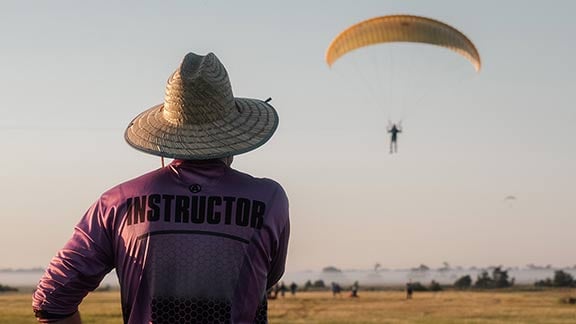The sport of Powered Paragliding has enjoyed tremendous growth in the past few years. Social media influence, word-of-mouth, and more visibility among the populace has resulted in a great number of new pilots adding to our ranks and joining us in the skies. It’s a golden age for our sport; with new equipment designs, new innovations, and a blooming population.
However, this growth comes with a kind of negative aspect, as well. In any group of humanity, as population trends upwards, so does the rate of accidents. Recently, we have been struck with the loss of several fellow pilots, many of whom were pillars of their community, beloved friends, and who will be sorely missed. In these times, it is important for us to reflect on safety so that we may all happily continue to enjoy flight in one of it’s most free and pure forms.

Firstly, we must be conscious of dangers around us. Low flying, flying around water, and flying in proximity to others offers some of the most exciting and rewarding flights of our lives- but it must be understood that these things carry a heavier risk. Water, in particular, offers us what statistically is our greatest danger. Collisions with low objects, in particular power lines, present massive risk as well. And we must do our due diligence with regards to assessing the conditions we fly in- because even when the air appears to be smooth and calm at first, there is no telling what nastiness lurks just over the horizon. And never underestimate Mother Nature’s ability to reach out and touch you- or swat you out of the sky. Do not give her that chance.
We must not rush things. We are easy prey to complacency; when a person has flown enough that it becomes routine, they can lose some of their fear; lose some of the critical respect for the equipment that keeps them alive. You’ve clipped in the same way a thousand times, but you should still check your lines before each and every take-off. You’ve pull-started your motor a thousand times,and it’s started and idled fine. But you should still check your throttle linkage for free play each and every time you pull the rope. You’ve flown over water a thousand times and nothing has gone wrong, but you should still bring flotation each and every time. It is absolutely imperative that we not fall victim to complacency, and that we instill this value in the next generation of Aviators.
We must understand that at no time are we obligated to fly. Going aloft with gear knowingly in a less-safe state, or with conditions less-than-ideal, is something that is unfortunately common, even among the best of us. A pilot with maturity is one who arrives to the field, ready for an amazing flight that he’s been planning for days; sees the clouds on the horizon, feels something off about the air- and decides that now is not the time to fly. Almost as gratifying as that amazing flight, is having a nice breakfast while you watch the gust front whip the trees around outside, and knowing that you aren’t in it right now because of your good decision making. Even if the weather and the gear are in good condition; are you? Lack of sleep or a poor mindset can contribute to poor decision making. Health conditions or substances that could affect judgement also may limit your ability to fly safely.
We must know our limits. Steep maneuvers, low flying, and swoop landings are all things that experienced pilots make look easy… but only by virtue of their experience. We must never exceed our limits or leave our comfort zone until we have attained that requisite experience. The path of progression needed to conduct these types of risky flying with confidence should be walked slowly, carefully, and consciously. And remember that the strongest homes are those with the sturdiest foundations.
We must know the limits of our equipment, too. Hotter, smaller wings should be earned by mastering their slower, larger counterparts first. The differences between breeds of wing can be rather shocking and can easily take an unsuspecting person by surprise. Before choosing a wing to fly, ensure it’s a good match for you; a powered paraglider needs both a pilot and a wing in equilibrium to fly safely. If you are constantly fighting a wing- or, conversely, pushing it too hard- failure may result. Our air-cooled two stroke engines should be maintained as well as they can be. However, we must be cognizant and constantly aware of the fact that they can, and do, break; sometimes in spectacular fashion, and sometimes in spite of excellent maintenance procedures by the pilot. On the other hand, we can take comfort in the fact that our aircraft needs no engine to execute a safe, comfortable landing. If we keep a safe “out” in mind at all times, we will never be hurt by engine failure.
Finally, and perhaps most importantly, we must realize that this sport is as safe as we make it. Our sport carries an unfortunate and unfounded stigma of being reckless and needlessly dangerous. In fact, your average pilot is not an adrenaline junkie, does not take unnecessary risk in the pursuit of his sport, and very much desires to keep living. And, all told, this sport is statistically quite safe. Our ability to fly in smooth air, without needing thermals or updrafts to stay aloft, means we suffer only half the fatalities of free-flight paragliders according to the USHPA. In fact, it is also statistically safer than motorcycle riding, which carries a fatality rate of 1 individual per 1,382 yearly, compared to our 1 in 1,504. If we keep our wits about us, do not rush, do not fall victim to complacency, understand the dangers around us, and understand our personal limits and those of our equipment, then each of us will continue flying well into the future.
